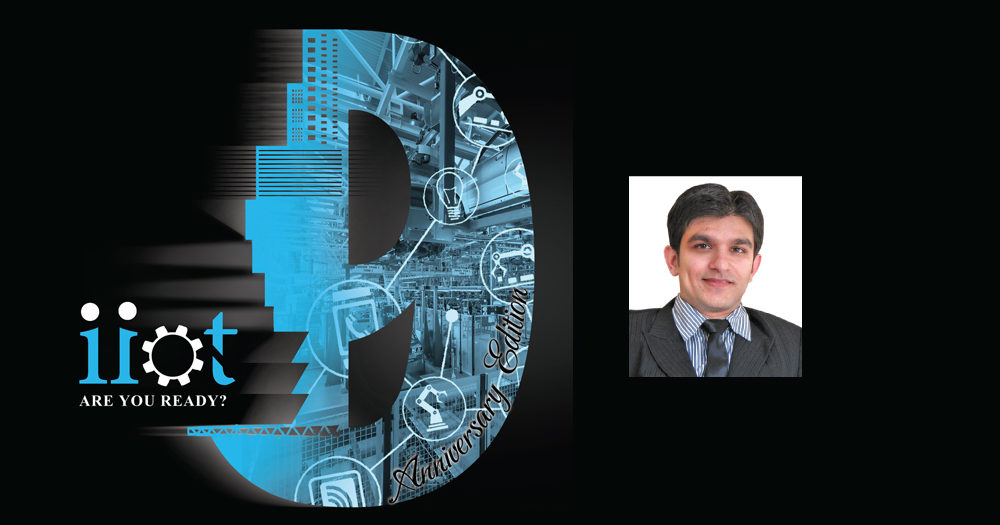IIoT: A key to make manufacturing more productive
June 13, 2018 12:17 pm
Maulik Patel,
Executive Director, Sahajanand Laser Technology Ltd
The IIoT has transformed the traditional face of the factory through streamlining processes and maximising production yields.
Future look for IIoT in manufacturing
The manufacturing industry embraced the technology that promises increased productivity and greater efficiency. According to Maulik Patel, Executive Director, Sahajanand Laser Technology Ltd, the IIoT has transformed the traditional face of the factory through streamlining processes and maximising production yields. There are many benefits that Internet of Things (IoT) can bring to the manufacturing sector.
More intelligent machinery
The traditional sphere of manufacturing, manufacturers can gain greater visibility of production performance. By supporting the early detection of delays to minimise the downtime and maximising the productivity.
Better data collection and analysis
By collecting the productivity and waste performance data, the manufacturers are able to make more informed decisions to improve the overall manufacturing process.
Improved resource management
By understanding the performance of a machine, the manufacturers can safeguard workers, reduce the associated operating costs and boost up productivity. The manufacturers must change their processes and how they work. Although for some companies, accepting this change can be scary by pushing them further towards their familiar working practices. By ignoring IIoT, the manufacturers can put their company at risk of being left behind as their competitors are embracing the technology and continue to march forward.
Industrial Internet in practice
There are dozens of IIoT applications already available. Companies are developing IoT applications at their work and they have started making a difference. The transportation and warehouse companies were benefitting from automated material handling trolleys and pallet trucks. In manufacturing unit, predictive maintenance and asset performance management are the key areas where the industrial Internet boosts up the value.
The predictive maintenance keeps the asset up and running by decreasing operational costs and saving millions of dollars. The manufacturers can use data streaming sensors and devices that can be used to quickly assess the current conditions, recognising the warnings, alerting the authorities and automatically triggering the appropriate maintenance process. The IIoT can also be blended with Artificial Intelligence which will transform the maintenance into a dynamic and automated operation.
Importance of edge analytics
The companies have been actively stepping into the IIoT cloud services. It is not necessarily a wise move to have everything in the cloud. During the critical stages of the manufacturing process, it is important that decisions can be made instantaneously. The manufacturers can benefit from the edge analytics in many ways.
The edge computing enables real-time analytics. In edge analytics, automated analytical calculations are stored on a single sensor, or on a network or on another device rather than data on central data. Open source computer hardware and software programs for IIoT are well coordinated, which at the right time is located on the edge of the network in a suitable processing location. In case of security, edge analytics is a great option over the cloud-based storage, as important information is kept in a computer firewall. Edge computing is important when the manufacturer needs real-time analysis and automatic actions to save the production line from important losses to heavy missions.
Creating value with IIoT
There is no value in the data without advanced algorithms of machine learning. The value can be created in a simple way by putting data to work. One can take the example of latest machine learning systems between the trucks which use a vehicle to vehicle communication system to connect the braking and accelerate between two trucks. This leads the trucks to control the simultaneous accelerating and braking the entire fleet which reacts faster than a human or even a sensor system. This leads the companies to save fuel cost with a remarkable number.
Industries that will drive IIoT adoption in 2018
Right from hand dryers to aerospace industries, there has been a wide range of innovative uses of the IIoT in 2018. However, there are some sectors that are conducting the production focused test cases and large-scale projects more than other sectors.
Sahajanand’s preparedness in the area of IIoT
The most important innovation to come from the integration of IoT and laser systems are the ability to automatically load and unload parts and materials without the assistance of a user. This is a significant benefit when it comes to increasing material handling capabilities.
The productivity and efficiency in the modern manufacturing environment often rely on automation. Patel explains, “With the IoT and the latest automation interface, it is now possible to integrate not only the laser systems to respond to the programmed inputs, but it has also controlled the multiple external devices including valves, compressors, air movers, signal lights, alarms and other programmable outputs. Besides, the inputs can be initiated from a diverse array of sources including the relays, digital logic signals from PLCs or microcontrollers that can be controlled from any number of remote sources.”
In smart automation, controlling the laser manufacturing through external devices is another benefit of the IoT. The laser engraving machines are designed to function as computer peripherals. The system comes with print drivers that enable users to print design file while also maintaining the compatibility with most software like CAD or CAM. However, there are intrinsic limitations in printing, the newer automation interfaces enable the option to directly import files to the laser control process through a network connection. This not only improves the quality of the engraving but is also compatible across different devices and machines.
Finally, by integrating the IoT into laser system operations, there is a potential improvement in safety in the manufacturing environment while also significantly reducing the liability. The safe operation of any laser system needs constant human supervision. Patel informs, “Using IoT can reduce the possibilities of errors and enable more consistent and flawless monitoring. Other risks that an automated laser system can reduce are exposure to direct laser energy, a risk of combustion, electrical dangers and exposure to exhaust.”
Lastly, he added, “The integration of IoT and laser technology is in its infancy and we will see new and exciting innovations in the years to come. For now, these exciting advances are taking productivity to new levels by changing everything about the modern industrial environment.”
Cookie Consent
We use cookies to personalize your experience. By continuing to visit this website you agree to our Terms & Conditions, Privacy Policy and Cookie Policy.


















